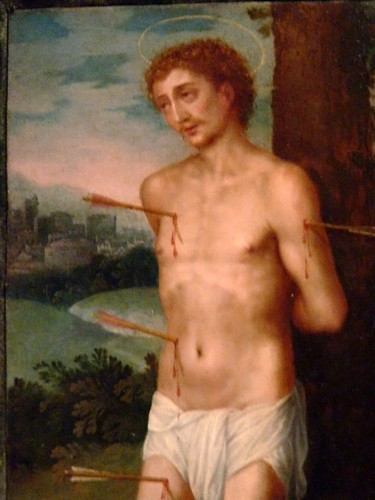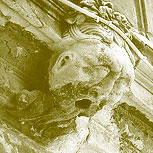 One of the topics I am very interested in investigating in The Splinter is the use of pain as a tool for religious transcendence and as a vehicle to achieving "ecstatic union with God" (Flynn).
One of the topics I am very interested in investigating in The Splinter is the use of pain as a tool for religious transcendence and as a vehicle to achieving "ecstatic union with God" (Flynn).The Christian use of self-flagellation seems to be seen as achieving a number of different goals :
1. An act of penance to punish oneself for sins committed and purify the soul.
2. As a blocker of sensual urges.
3. As a ritual sacrifice.
4. Vicarious pain as a vehicle towards sameness - the imitation of Christ.
5. To precipitate ecstatic visions and an experience of union with the divine.
Today, we see pain as being wholly negative. Self-inflicted pain is seen as not only negative, but as an incontrovertible sign of psychological disorder (Walsh). In his review of Glucklich's book, "Sacred Pain", Steven post remarks that "the ability to control pain medically has created a culture in which the experience of pain is judged to be unacceptable and, when completely unavoidable, unambiguously tragic" (Post).
Yet still there are some cultures and societies in which these rituals are practiced, notably in the Philippines (Barker), and in the Opus Dei, whose founder wrote " I don't believe in your interior self-denial if I see that you despise, that you do not practise, mortification of the senses" (Escriva).
Moira, the female protagonist in The Splinter, would seem through modern eyes to be a very psychologically troubled teen. There is a desire, on the part of the reader, to ascribe her acts of self-flagellation, as part of a pathology left from some dreadful trauma. The reader naturally expects that it will turn out that she has been abused in some way. In fact, I purposefully killed off her father, before the story begins, in order to remove the obvious assumption that she has been molested.
I don't want to offer readers an easy answer to Moira's self-inflicted violence. However, in this draft version, after getting some quite specific feedback, I realize that I have not given the reader enough alternative reasons; I have not investigated her immense sense of loneliness early enough in the story.
I'm a little trapped here, because at one point or another in the story, Moira gives many reasons for her mortifications, all the ones I've listed. I wanted to show her own lack of understanding about what drives her. I wanted the reader to take that same journey, but I have given no alternate clues, hanging at the corners of the text. And I need to do this. I'm not quite sure how.
The more I investigate the writing of this work, the more I realize that it is essentially a story about existential loneliness. I'm an atheist - I don't believe that what Moira sees or feels is God. But I do believe passionately in her anguish. And I do believe that she sees this union as the only way to assuage it. And pain as a way to effect this union.
So, how does self-inflicted pain do this? Reading a number of primary documents: letters and autobiographies as well as instructional and devotional texts by notable mortifiers gives some clues.
In his "Ascent of Mount Carmel", St. John of the Cross writes:
"For until the desires are lulled to sleep through the mortification of the sensual nature, and until at last the sensual nature itself is at rest from them, so that they make not war upon the spirit, the soul goes not forth to true liberty and to the fruition of union with its Beloved." (St. John of the Cross).For him, self-flagellation is a way of dulling the calls of the flesh, quieting the distraction of them so that the soul can concentrate itself on the union. Ligouri agrees: "External mortification helps internal mortification and it is in a certain sense necessary in order to control one's senses" (Jones).
Catherine of Siena tended to see her pain part of a purification process. She speaks in God's voice when she writes: "When my servants remain united to me I prune them with great suffering so that they will bear more and better fruit" (Catherine of Sienna) and St. Francis Borgia felt similarly: "Thus did he apply himself to the mortification of his senses and the crucifying of his flesh. And it was hereby, he arrived at so high a pitch of sanctity and perfection" (Rodriguez).
In "The Interior Castle", Teresa of Avila infers an intimate association between the experience of pain and ecstatic vision: "just as the soul is about to become enkindled, the spark dies, and leaves the soul yearning once again to suffer that loving pain of which it is the cause" (St. Teresa of Avila).
Louis de Montfort believed that in order to have union with God, a level of spiritual 'wisdom' had to be attained and that the experience of pain was the gateway to this wisdom. "Wisdom is not satisfied with half-hearted mortification or mortification of a few days, but requires one that is total, continuous" (Montfort).
In his book on St. Rose of Lima, Frank Graziano attempts to attribute the totality of her self-harming to a sublimation of sexual urges (Graziano). Although I don't agree with him, I think he gets very close. He is very much swayed by the language that is used to describe her as being a "bride of Christ" and it is true that she was married to him in a "mystical" wedding ceremony. He associates this with many earlier European writings that contain obvious erotic language and imagery in their descriptions of sacrifices, mortifications, and the general devotions of many of the saints who pursued ecstatic experience. I think this is a fair reading.
Similarly, Hilary Fraser's reading of St. Teresa's divine visitation with an angel who pierces her heart is that of sexual sublimation:
"The element of sexual repression in her account is unmistakable...never has religious ecstacy been expressed in such erotic terms. St. Theresa is ravished by the beautiful seraph with his phallic fiery spear, and her intense pleasure/pain is the bittersweet pain of sexual climax" (Fraser)There is no doubting that the passage she refers to is erotic. However, where is the repression? Angels are specifically described as having no genitals - so how might congress take place, other than metaphorically? It seems to me that in all these readings, there is a desire to see as repressed or sublimated what is quite clearly expressed. The problem, for the interpreters is that they cannot conceive of a sexual/conjugal relationship with anything other than another human being. But all these women could and did.
However, referring back to my previous post on desire, I believe this differentiation between eros and agape is erroneous. And therefore, this eroticism of pain and the physical yearning for divine presence is not a sublimation wherein the lover uses God as a proxy, but rather that the object of erotic desire is God, that pain is believed to allow for mortals to have intimacy with God, and that the ultimate consummation of that love takes place after death.
References:
Flynn, Maureen. "The Spiritual Uses of Pain in Spanish Mysticism." Journal of the American Academy of Religion 64.2 Summer, 1996 257-278. 22 Apr, 2008 http://www.jstor.org/stable/1466102.
Walsh, Barent. "Review: The Scarred Soul." Psychiatric Services 51.6 June 2000 821 - 822. 22 Apr, 2008 http://psychservices.psychiatryonline.org/cgi/reprint/51/6/821.
Glucklich, Ariel. "Self and Sacrifice: A Phenomenological Psychology of Sacred Pain." Harvard Theological Review 92.4 October 1999 479-506. 22 Apr, 2008 http://www.jstor.org/stable/1509869.
Escriva, Josemaria. "The Way: Mortification." Escrivaworks. unknown. Opus Dei. 22 Apr 2008 http://www.escrivaworks.org/book/the_way-point-181.htm.
Post, Steven. "Sacred Pain: Hurting the Body for the Sake of the Soul." First Things: The Journal of Religion, Culture and Public Life March 2002, 22 Apr, 2008 http://www.firstthings.com/article.php3?id_article=1982.
Barker, Nicholas. "The Revivial of Religious Flagellation in Lowland Christian Philipines ." 1997. University of Hawaii at Manoa. 22 Apr 2008 http://www2.hawaii.edu/~millado/flagellationfolder/flagellation.html.
St. John of the Cross, "Ascent of Mount Carmel." Catholic First. unknown. 22 Apr 2008 http://www.catholicfirst.com/thefaith/catholicclassics/johnofthecross/ascent/ascent03.cfm.
Rodriguez, Alonso. "Mortification: The Practice of Christian and religious perfection, Vol 2. ." Google Books. 22 Apr 2008 http://books.google.com/books?id=WjbnjEusunkC&pg=PA70&lpg=PA69&vq=Francis+Borgia&output=
html&sig=2PWt0CoyV-J7950ObYUrDZTiOsc.
St. Catherine of Siena, "The Dialogue of Saint Catherine." Intratext Library. Unknown. 22 Apr 2008 http://www.intratext.com/IXT/ENG0139/_P1X.HTM.
St Teresa of Avila, "The Interior Castle - Six Mansions." Catholic First. Unknown. 22 Apr 2008 http://www.catholicfirst.com/thefaith/catholicclassics/stteresa/castle/interiorcastle4.cfm.
Jones, Frederick. "Selected Writings By Alfonso Maria de' Liguori." Google Books. 1999. Paulist Press. 22 Apr 2008 http://books.google.com/books?id=aTg754j-t0C&printsec=frontcover&output=html&sig=
5-nDeW_DLnnBRBjpH4J3h0GS9hQ.
Montfort, Louis de. "The Third Means: Universal Mortification." The Love of Eternal Wisdom. 1989. Eternal Word . 22 Apr 2008 http://www.ewtn.com/library/Montfort/LEW.HTM#Sixteen.
Graziano, Frank. "Wounds of Love: The Mystical Marriage of Saint Rose of Lima." Questia Online Library. 2004. 22 Apr 2008 http://www.questia.com/read/104900403.
Fraser, Hilary. "St. Theresa, St. Dorothea and Miss Brooks in Middlemarch." Nineteenth Century Fiction 40.4. March, 1986 pp 400 - 411. 22 Apr 2008 http://www.jstor.org/stable/3044729
800 words (4,370 and counting)



